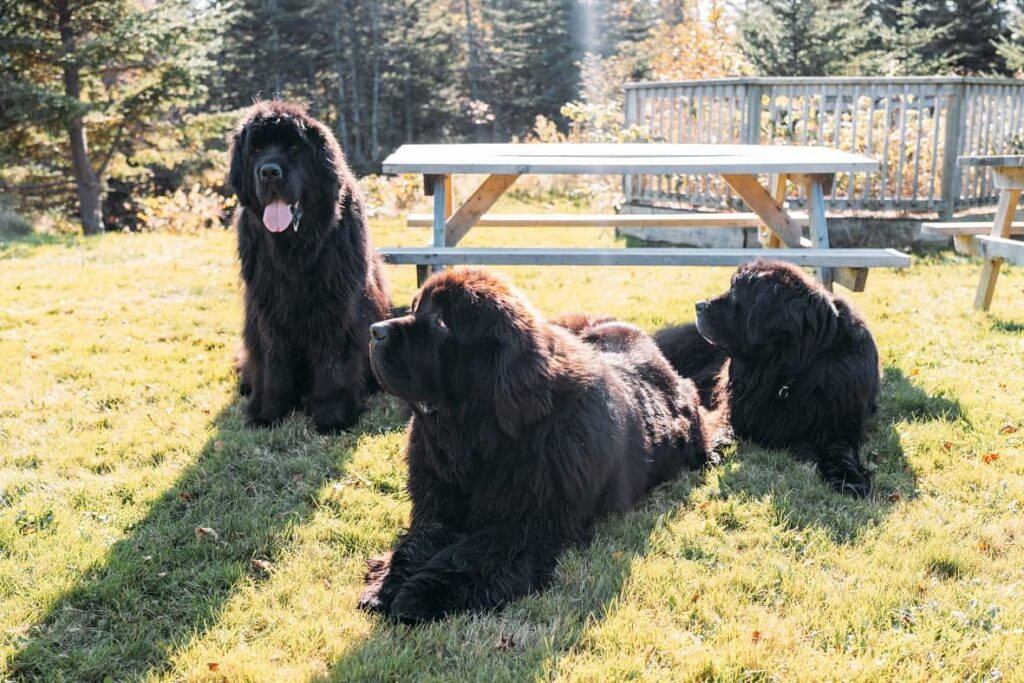With each passing month we are nearing the one-year mark of living in a world ravaged by the COVID-19 pandemic. Entire cities are closed, global markets ruined, and day-to-day life as we know it disrupted. Out here in our Atlantic bubble, however, we can at least enjoy a degree of normalcy. It lets us reflect on the other big issue of the day: namely, how big is the biggest Newfoundland dog in Newfoundland?
It’s an age-old
question which has occupied the minds of many, or at the very least,
it occupied my mind during the lockdown earlier this year. They’re
big dogs, but there has to be a biggest—right?
The short answer is: yes. And we found him. But it was a long journey, and over the course of our travels we met many a good boy and girl along the way, old and young, all the biggest in someone’s heart. And who are we to exclude them?
‘All the virtues of Man without his Vices’
For those somehow unfamiliar with these gentle giants, the modern Newfoundland dog traces its lineage back to a time when the dogs were working animals. They helped fishermen pull heavy loads of catch and, perhaps most importantly, used their well-honed lifesaving and swimming abilities to rescue those who fell overboard. Even today, Newfoundland dogs can’t help but ‘rescue’ their owners while out for a swim.
Throughout
history there have been dogs like Bilbo, Rigel, Hairy Man, and
Swansea Jack, who, from the shores of Isle aux Morts to swimming
alongside the lifeboats of the Titanic, spent their lives saving
people from drowning.
Famous explorers too have relied on Newfoundland dogs’ survival skills: a dog named Seaman accompanied the Lewis and Clarke Expedition all the way to the Pacific. Sir John Franklin’s dog Neptune was lost along with him and the rest of his ill-fated arctic expedition.
A storied breed favoured by artists, adventurers, and royals alike, Newfoundland dogs have been admired by American presidents, as loyal companions to Lyndon B. Johnson and Ulysses S. Grant—as well as Senator Robert F. Kennedy.
Outside of
presidential companionship, Newfoundland dogs have also had a
celebrated history in war-time, both as mascots and on the front
lines. Sable Chief was one such mascot of the Royal Newfoundland
Regiment, and now resides at the Rooms in St. John’s. Another brave
Newfoundland dog named Gander, referred to by his compatriots as
Sergeant, not only acted as the mascot of the Royal Rifles of Canada
during the Second World War, but was posthumously awarded a medal of
bravery for carrying a live grenade away from soldiers during the
Battle of Hong Kong.
These were the
qualities that led John Hobhouse to eulogize Lord Byron’s beloved
Newfoundland, Boatswain, as a creature that possessed “Beauty
without Vanity, Strength without Insolence, Courage without Ferocity,
and all the virtues of Man without his Vices.”
Size Isn’t Everything
Unquestionably large dogs, the average height of a Newfoundland dog ranges from 66-71 cm, with the average weight of an adult dog falling somewhere from 120-150 lbs. While some people might think that size is everything when it comes to these dogs, however, there are far more important factors to consider when talking about their overall health.
“Like with any other breed, keeping a dog lean and muscular will contribute to a healthy life,” Monica Dominguez, a former Newfoundland breeder who operates the Killick Dog Wellness Center in Torbay, tells the Independent. “Maintaining a healthy weight and an active lifestyle is very important, especially for a large or giant breed.”
Dominguez thinks
that people can get too hung up on the size of the dog, without
considering what else they need to live a healthy life. Given the
breed’s history and disposition, off-leash time and plenty of
exercise, including swimming, helps to keep Newfoundland dogs fit and
diminish the risk of potential injuries as they grow.
Dominguez says
it’s important that owners are not over-feeding their dogs, which
can increase size and put a strain on their joints. “You should be
able to feel the space between their ribs as well as the collarbone
easily when petting them,” she explains.
Though there are
a number of different diets that are available for dogs, Dominguez
advises owners to make sure their pets have plenty of fresh, natural
sources of protein.
“Variety is the
key for a balanced diet. They thrive with fish, as this was what they
were given in their origin.”
One thing that
Dominguez says potential owners may not be taking into consideration
when thinking about getting a dog of their own is the sheer amount of
work which goes into owning the breed. While they might seem docile,
Newfoundland dogs are known for their intelligence and will get bored
easily, meaning owners need to set boundaries from day one.
“Newfoundland dogs are a high maintenance breed in all aspects: they need regular grooming. They can get messy. Some slobber more than others, but drool will be part of your life,” Dominguez explains.
Many owners will
attest to the breed’s clinginess and need for physical contact:
nearly all of the dogs that we met for this piece were quick to say
hello before sitting squarely on our feet and leaning their weight
into our legs.
“Their physical
demands are huge,” Dominguez tells the Independent, “but their
emotional ones are just as important. It is very important to
socialize them and expose them so they learn to adjust to new
situations early in life.”
Overall, she
recommends potential dog parents do their research on the breed and
try to meet as many Newfoundland dogs as they can before making their
decision. If owners do have their heart set on one of these lovable
giants, Dominguez recommends reaching out to a good breeder.
“Reputable and
committed breeders will be there to help and guide you during the
life of your puppy,” she says. “They will ask you a lot of
questions to make sure you will be the right match. They will be
involved with the upbringing, and will be there to support you and
answer your questions.”
DOG PROFILES
(*Photos include a 6’1” goofball for scale.)
Nielson
4 years 120 lbs Loves plain Timbits.
Nielson might
have been the smallest of his litter, but he has the highest energy
of any Newfoundland dog we met. Doesn’t like sitting on the dock,
but loves his beagle brother.
Chief

6 years 150 lbs Doesn’t like cheese.
Chief is a bit of a celebrity: aside from being the dog in the Johnson Insurance commercials, Chief might well be the most photographed dog in the province, often posing for tourists and locals alike atop Signal Hill.
Odessa

9 Years 140 lbs Calendar model.
A little timid,
Odessa might be afraid of the big dog statues in the park, but is
certainly not afraid of the camera.
Luna

13 Years 120 lbs Reality TV star.
Once featured on
the Amazing Race, Luna is a sweet old girl who likes to sprawl out on
the floor, and was a particularly good sport waking up from her nap
to take a quick photo with us.
Jay & Kasey

Jay:
5 Years 130 lbs A very fast runner.
Jay didn’t seem
terribly keen on going to obedience training, but came around to it
eventually. A true Newfoundlander if ever there was, this friendly
pup loves the woods.
Kasey:
4 Years
150lbs
Got ‘er
moose, b’y.
Perhaps a touch
mischievous, Kasey enjoys the outdoors and, of course, the scatter
moose bone.
Gabe

11 Years 130 lbs Hockey fan.
Another in a long
tradition of four-legged mascots, Gabe dropped the first puck at the
Growlers game.
Oscar

10 Years 135-140 lbs Loves a good swim.
Oscar likes to
get in the water as much as the next Newfoundland dog, and was quick
to go for a dip after getting his picture taken.
Tiempo

3 Years 178-200 lbs The biggest.
Much like the Highlander, there can be only one: truly, a gentle giant among giants.
Main Photo: Tiempo, Gabriel, and Oscar. All photos by Jessie Evans.
The Independent is 100% funded by its readers. Your pay-what-you-can subscription or one-time donation provides a base of revenue to keep our bills paid and our contributors writing. For as little as $5 a month, you can fund the future of journalism in Newfoundland and Labrador.
Donate


